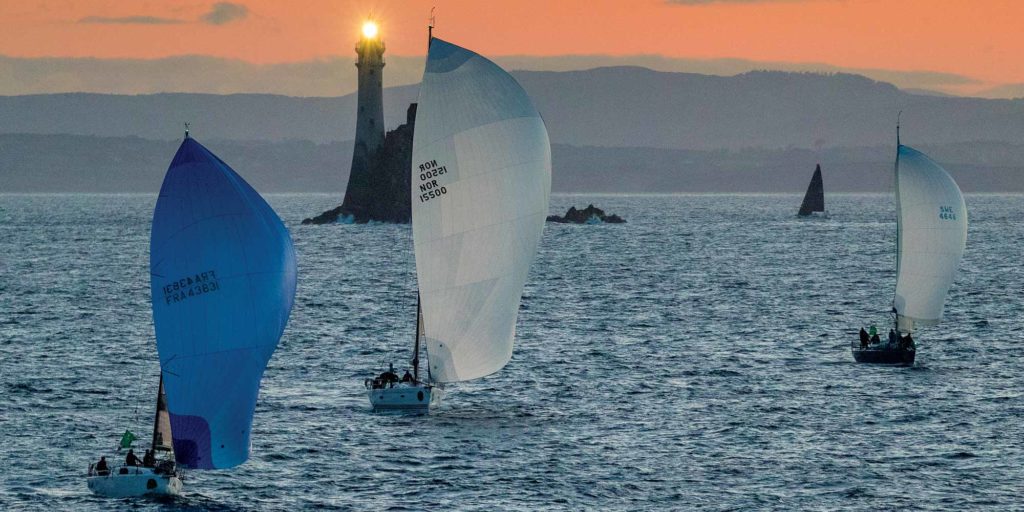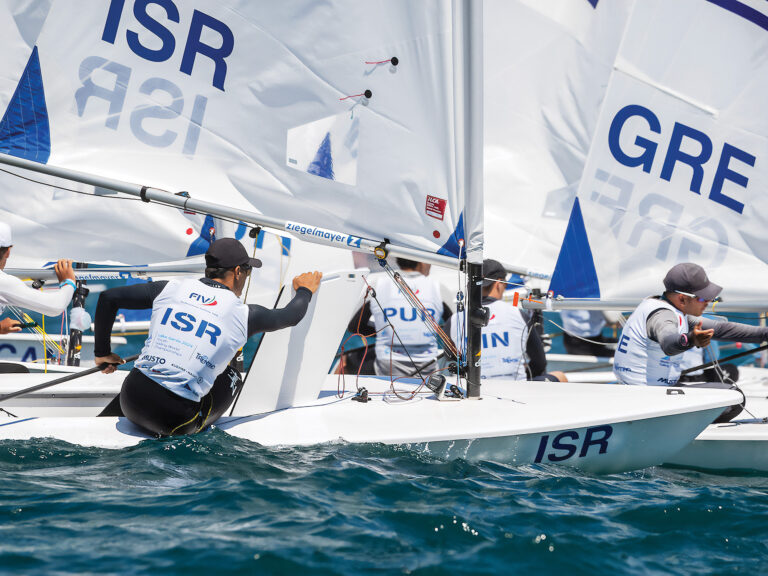
The Rolex Fastnet Race started early again this year, kicking off at midday on a cold and gloomy January Monday. This start wasn’t on a crowded Solent, but rather at the Royal Ocean Racing Club’s offices in London when the online entry portal opened for business. There were 340 places available in the IRC fleet, and they were all gone in 4 minutes and 37 seconds — a mere 13 seconds outside the record achieved in 2017. The reserve list has a hundred boats on it.
The record sign-up runs counter to all the things we read about modern life — attention spans are dropping; no one wants to do anything for more than a couple of hours; the multiplicity of entertainment now on offer is diluting participation generally; and sailing in particular has lost its way in attracting and keeping its people.
None of which seem to apply to the Fastnet Race. The first boat to enter this year was Venomous, a Farr-designed, Carroll Marine 60 owned by Derek and Sandra Saunders. Derek has completed 14 Fastnet races, going back to the 1980s. They now race their boat as a business called Windward Sailing, which offers paying clients the opportunity to do the race, along with all the qualifying sailing.
The desire to participate in the RORC’s classic has made the entry period a stressful time. “It’s led to a stressful New Year for those who really want and need to do the race,” Derek says. “As a charter company, we need to reassure our clients that their participation is assured as long as the sailing part is complete, and not be told ‘sorry we can’t sail the race as we do not have an entry.’”
The demand to do the Fastnet — whether from individuals signing up with companies such as Windward Sailing or owners wanting to take their own boats — comes at a time when the entry and qualification demands are stricter than ever. In the case of the Fastnet, the experience requirements mean that at least 50 percent of the crew must sail 300 nautical miles of RORC (or equivalent) racing, sailed within 12 months of the start of the race. There are additional rules mandating that survival and first-aid training be undertaken as well. And that’s just the crew. Each boat must meet OSR Category 2, plus the RORC’s additional prescriptions.
Given all hurdles — and let’s not get started on the cost — what is it about these races that keeps bringing people back in such huge numbers? The first boat from the United States to enter the 2019 race was Joseph Mele, with his Cookson 50 Triple Lindy. Ironically, he didn’t have to rush — as a RORC member he gets a week to register interest in the race, since members have first priority — but he did anyway. “I was too excited about the race not to submit my entry as soon as possible,” he says.
Mele’s crew consists of committed offshore racers; they raced the Newport Bermuda, Sydney Hobart, Fastnet and Middle Sea Race in one 16-month period and also have done the Caribbean 600. When they first entered for the Fastnet in 2017, the entry period came right after they had completed the 2016 Sydney Hobart Race.
“I was vacationing in New Zealand with my family, and because of the time difference I had two crew members back in the USA assigned to submit our entry as soon as the process opened,” he says. It turns out the back-up was necessary, after an internet connection failed. “It took us 28 minutes to submit the entry, and after reading that over 400 boats had applied in the first five minutes or so, I was sure we had missed out.”
RELATED: Full for the Fastnet Race
What is the appeal for Mele?
“I came to offshore racing from a cruising background,” he says. “I love the natural beauty of being offshore for sunrises, sunsets and different weather systems. I enjoy putting a fun, compatible and competent crew together to tackle the adventures and challenges that offshore racing involves.”
Eddie Warden Owen, the Royal Ocean Racing Club’s chief executive, has noticed that offshore racing now appeals to an entirely different group of people than those that race inshore.
Derek Saunders also sees the attraction of the personal challenge. “The Fastnet Race is an iconic race that represents to many weekend sailors their personal Everest,” he says.
Saunders started taking people around the Fastnet Rock 30 years ago. “The 1979 Fastnet disaster brought the race to the attention of the general public, as it received a lot of media coverage. It’s ironic that instead of putting people off the idea of competing in the race, many see it as a challenge — which of course it is.”
Eddie Warden Owen, the Royal Ocean Racing Club’s chief executive, has noticed that offshore racing now appeals to an entirely different group of people than those that race inshore. And he feels that this might be the key to its growth — the sustainability of so many other long-distance ocean races such as the Bermuda Race, Transpac and the newer Caribbean 600.
“There used to be quite a big overlap years ago,” he says. “People would do the Solent points [a series of inshore day races], and they would do offshore racing. Now it’s clear from the IRC Europeans that we did last year that inshore racing appeals to a much narrower band of people. We only had 30-odd boats; we had half the fleet that we expected. Very few of those were the boats that really sail with us offshore.
“The offshore people didn’t want to do the inshore racing, and the inshore guys didn’t want to do the offshore, and that was interesting. Also, when the Offshore Sailing World Championships was going on in Scheveningen in Holland with just under 100 boats, there were 125 boats doing the Cowes to Dinard to St. Malo Race.”
There are people who want to go offshore, he adds, because of the quality of the crews they have.
“If you want to win inshore, you’ve got to really be on the boil with crew, with your boathandling and performance, you really need to be up there,” Warden Owen says. “Yet offshore, you can have a really good race, and the result doesn’t really matter — you’re with your mates, you’re with your friends. You’ve got more time to change sails. The tack at the windward mark doesn’t really matter that much. It’s about strategy and tactics. And it’s probably about switching the phone off and saying, ‘I’m away from work, I’m doing something that I enjoy, and I’m with a group of friends that I enjoy sailing with.’
“I can only imagine that that’s why people prefer it. They know they can’t win inshore, but they have a chance of getting a decent result offshore, which enthuses them. Then there’s the challenge of the navigation, there’s the arrival at a port and a nice meal, a few drinks with your mates, and then somebody steers the boat back while you have a sleep.”
Warden Owen suspects that the success of the Fastnet is an extension of its popularity. “Because it has got a worldwide reputation, and the fact that it’s limited to 340 boats means there has been a bit of a push to try and get in the race,” he says. “And it has come down to how quick are you on your computer at midday, the first week in January.”
The popularity of offshore racing is not restricted to the Fastnet; while the RORC’s glamorous centrepiece is the big daddy in this field, the Newport Bermuda Race attracted 170 entries to the starting line in 2018, the Sydney Hobart Yacht Race had 92, and the Caribbean 600 (also run by the RORC) got a record of 88 boats in 2018. The Rolex Middle Sea Race also drew a new record of 131 registered entrants in 2018, the race’s 50th-anniversary running.
While such races remain popular, the entry levels are mostly static and short of the entry limit, however. There is something about the Fastnet in particular, and much of that might just be about accessibility. There are lots boats geographically close to the racecourse, particularly in some of the powerhouses of offshore racing — France, Holland, Germany, Scandinavia and the U.K. While the phenomena is reflected worldwide to some extent, it is strongest in Northern Europe, and it finds its greatest expression in the one classic race in the region — the Fastnet.
“To back up this idea that in our area, the Channel, Northern Europe, offshore racing is getting stronger is the fact that last year, all our races were above the target that we’d set,” Warden Owen says. “We were above all those targets in 2018, a non-Fastnet year. This year we would expect it to be up again [because of the Fastnet], but we think it will be above 2017, because the interest seems to be growing.”
The RORC has played its part in encouraging the growth by simplifying online entry with a bespoke software system that records and stores each entry’s unique details.
“If you come back every two years, it’s there, all your information is there,” Warden Owen says, “and we try and make sure that everybody gets into the same marina; we have a great party at the end, and I think we try and make the competitor experience as challenging and fun as possible.”
Whatever the secret sauce may be, long may it continue to work.
The biennial Newport Bermuda Race serves as one barometer of the health of ocean racing in the United States. Despite increased safety regulations and costs to compete, the race has maintained healthy participation for two decades.
- 2000 – 175 starters
- 2002 – 182
- 2004 – 154
- 2006 – 263 (centennial year)
- 2008 – 197
- 2010 – 183
- 2012 – 165
- 2014 – 163
- 2016 – 133 (predicted storm)
- 2018 – 170









